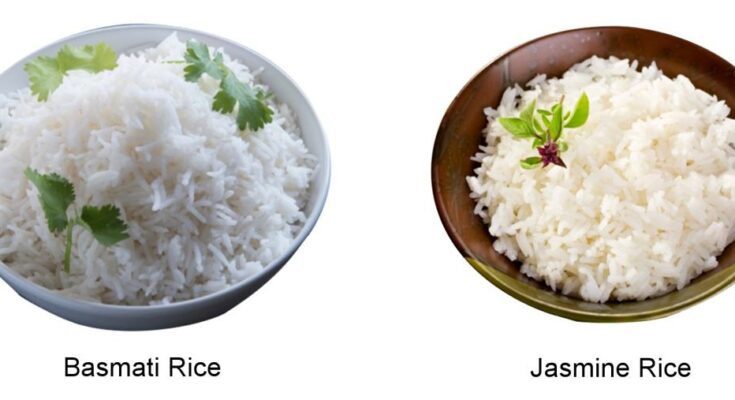Rice is among the widely consumed food staples around the globe. It’s the third-largest cultivated crop after maize and sugarcane. Asian and African people eat rice daily with curries and soups. It’s not just good in taste but also rich in vital nutrients. You will wonder to know that there are 120,000 different varieties of rice in the world. Rice is majorly divided into three categories, short-grain rice, medium-grain rice, and long grain rice.
Out of the above three types of rice, long-grain rice is the fluffiest and healthier. They are used in regular meals as well as for special occasions. They are rich in carbs and fiber. The long-grain rice contains less starch, that’s why it possesses a non-sticky texture. They expand almost double on cooking. Their firm and dry texture make them the best for cooking biryani and fried rice. Their length is around 4 to 5 times longer than the width.
Generally, there are three types of long grain basmati rice: Basmati rice, Jasmine, and American long-grain rice. But there is a difference in their texture, taste, and fragrance. Here are the major differences between Jasmine and Basmati rice.
Origin
Basmati rice has its roots from the foothills of the Himalayas and is extensively cultivated in India and Pakistan. India is the largest exporter of Basmati rice worldwide and produces high-quality Basmati. This rice has been grown in northern parts of India (Punjab, Haryana, Himachal Pradesh, Up, J&K, and Uttrakhand) for centuries and well known for its appetizing aroma and mouthwatering taste. The first variety of Basmati rice was “Heer Ranjha,” which was grown in the region of Punjab. You will also find some varieties of Basmati rice in the U.S.
On the other hand, Jasmine rice hails from Thailand and is also known as “Khao Hom Mali.” It is named Jasmine because it releases the fragrance of jasmine flower when cooked. Now, these rice are eaten all over the world, but the remnants of history suggest that in earlier times, it was cultivated only for the royal kingdom’s royalty. Besides Thailand, this rice is also grown in Vietnam and Cambodia.
Shape and Size
Both Jasmine and Basmati rice are long-grain rice, but Basmati rice is a bit longer than the Jasmine. The minimum length of Basmati rice is 6.61 mm and goes up to 8.2 mm.
Talking about the shape: the Jasmine rice has slightly round edges and a translucent in color. On the other hand, Basmati rice has sharper ends and dense white in color. The length to breadth ratio of Basmati is around 3.0.
Different Varieties
Jasmine rice comes in three versions: white, brown, and black. Out of these, Black Jasmine rice is very rare. Brown and Black Jasmine rice are healthier than the polished one because it’s rich in fiber, antioxidants, and vital vitamins. They are good for your skin, eyes, and immunity power.
India produces 70% of the world’s Basmati rice, and here you will have 29 varieties, some of which are 1121 Basmati rice, Kasturi basmati rice, Mahi Sugandha Basmati Rice, Pusa Basmati rice, Ranbir Basmati rice, Vallabh Basmati rice, etc.
Aroma And Flavour
Both Jasmine and Basmati rice contain a compound 2AP, which releases a fragrance like classic popcorn. Hence, the aroma of both of these rice is almost the same. The flavor of Jasmine rice is quite nutty and sweet, while Basmati is slightly tinder than Jasmine.
Texture
The Jasmine rice gains little moisture on cooking and becomes a bit sticky, whereas Basmati rice is a grain that remains separated and dry. So, if you like to eat more fluffy, long, and dry rice, it would be better to go with Basmati rice.
Iron Content
We all know how important iron is for our mental and physical well-being. The processed Basmati rice contains 2% iron, but unfortunately, iron is not present in processed Jasmine rice.
Glycemic Index
Glycemic index is a number that gives an idea about how fast your body digests a particular food. The higher the Glycemic index, the faster the food is absorbed. The GI of a Jasmine rice is 109, whereas Basmati rice is 58. This shows Basmati rice is a good option to maintain a healthy weight.
Uses
Basmati rice complements the curries and is used for making biryani, pulao, fried rice, etc. Jasmine rice is accompanied by south Asian cuisines like Nasi Katok, Naem Khao Tod, Arroz Caldo, etc.
Cooking Method
You have to wash both types of rice before cooking; this will remove dirt and extra scratch from them. Jasmine rice can be steamed or boiled. But it is better to prepare basmati by boiling.
The Bottom Line:
The unpolished version of both Basmati and Jasmine rice are healthier alternatives. They are rich in protein and fiber and high in nutrients.
Authors Bio -: For the last 10 years, Somnath Verma has been writing about basmati rice, and he aims to promote basmati pedigree across the world. He is the marketing manager at Supple Tek Ltd by profession and an enthusiastic writer by passion.


